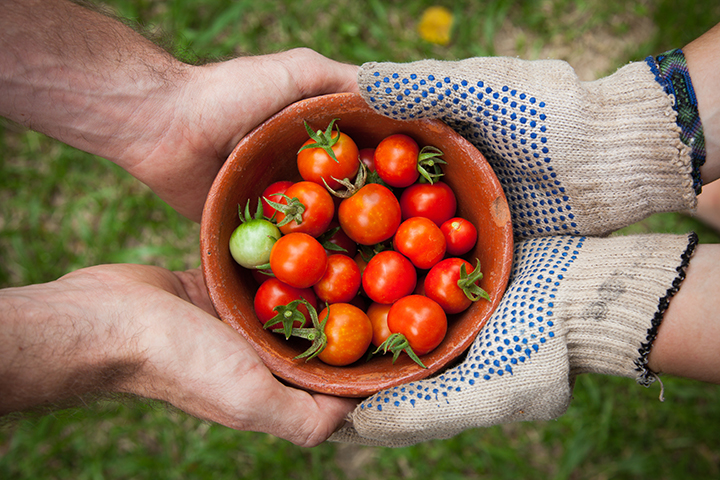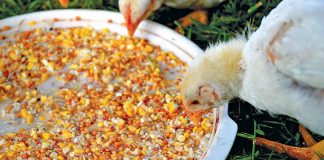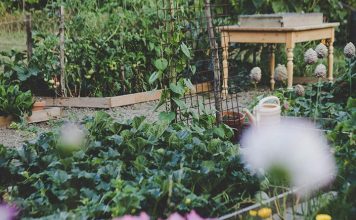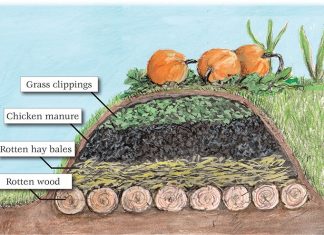 |
|
| Issue #53 • September/October, 1998 |
For some reason, (definitely unknown to me) canning, as a method of very long term food storage, fell into disuse. Maybe it’s the hurry/rush syndrome many folks have become addicted to, necessitating “instant” foods, microwave ovens, and mixes for everything from pancakes to casseroles. But for people of a self-reliant inclinationraising a good portion of their own wholesome, chemical-free food and establishing a storage method that is easy and results in tasty food, even years down the roadhome canning is the way to go.

Check each jar after it cools with one finger, being sure it is tightly indented; if it is not, it is not sealed, and must be redone or eaten soon. It needs refrigerating until then. |
And remember, no power outage or mechanical failure will cause your pantry full of home canned food to go bad, as can happen with frozen food. This is the reason I do not freeze food now. I lost half a freezer full of food due to a two-week-long ice storm power outage. Besides, where food only stays good for a year, max, in the freezer, it stays great tasting for years on the pantry shelf neatly packaged in shining glass jars.
I regard home canning as essential to self-reliance as any other facet of my lifestyle. Canning allows my family to eat chemical-free, delectable fruits, vegetables, nutmeats, pickles, preserves, jams, and jellies, as well as meats and fish, already cooked and tender, just waiting for a meal.
I can year-round, making up such things as chili, stews, dry beans, (like pintos for refried beans), spaghetti sauce, pizza sauce, smoked trout, elk stew, etc. Whatever the season, there’s always something special to can up for later meals. Nearly anything you can find on a store shelf can be canned easily at home.
When I tell this to people, I’m usually met with the same blank stare and the questions: Isn’t home canning hard to do? Won’t eating home canned food give you food poisoning? Won’t the canner blow up?
No. Canning is very easy. If you can boil water and tell time you can home can. Properly canned food will not give your family food poisoning. I’ve canned for 35 years and no one has ever suffered from the least bit of ill effect from my delicious home canned food. And no, the canner will not blow up despite the old cartoons to the contrary. My old canner is 20 years old, has received very heavy use, and is still going strong, with no repairs necessary.
It is simple to start out. Canning doesn’t even require a pressure canner, which can be a bit expensiveabout $130-$150. (Remember, though, that this is often a once-in-a-lifetime expense, bringing the cost down to less than $10 a year.) A person may begin canning with a water bath canner, available at most discount stores for under $20. These are the big blue pots with a lid and wire rack you may already be familiar with. You can also find them at yard sales for as little as a dollar. Just hold them up to the light and stick your head inside to be sure there are no small holes allowing leakage.

Tomatoes: 15 minutes from garden to spaghetti sauce, pizza sauce, tomato paste… |
Jars do not have to be purchased new. Just get word around to your neighbors and friends that you are going to be canning and need jars. A note tacked up on a grocery store or feed store bulletin board or placed in your local advertiser paper will also work wonders. Any jar that a canning jar lid and ring will fit onand is chip and crack freewill work. Despite rumors, such jarspreviously containing such things as honey, mayonnaise, Sanka, etc.will work for home canning. I have used them for many years even for such things as corn, meat, and fish, all of which require long, pressure canning. They do not break any more often than do brand name canning jars. And canning jars last for generations. I am canning with a few of my grandmother’s old blue Mason Jars.
Pick up a good, fairly recent canning book. This is a “must,” as it contains time tables, specific directions for many, many different foods, as well as a lot of recipes for home canned goodies. You can also ask your county extension office for literature on home canning. It’s usually free for the asking. Or go to your library. But, if you plan to keep up with your new endeavor, you will want a detailed book or booklet of your own.
Do not try to can using those “country style” cute jars with zinc lids, glass lids, and rubbers. Not only are they expensive, but you cannot tell if they are properly sealed. A jar improperly sealed will allow the food to spoilnot a good thing.
Often, when your friends or neighbors give you jars or you buy them at a flea market, auction, or yard sale, you will also get some rings. These are reusable for years and years, serving only to hold the flexible metal lid down on the jar rim during the canning process. The rings need only to be solid and strong. Rust is of no consequence, unless it is so bad that the rings are flimsy.

Green beans: 15 minutes from garden |
Lids need to be bought new for each use, for if the lid has been bent on opening it will not reseal, and the rubber is usually only good for a one-time use. Further use may result in seals which come loose or a lid that will not seal. Both conditions are a waste of money, time, and the result can be dangerous, i.e., food spoilage.
Canning with the hot water bath is a simple process: cleaned, sterilized (boiled) jars are filled with (often) hot high-acid food. The jar rim is wiped clean. A hot, boiled new lid is placed on the jar. And a clean ring is screwed firmly onto the jar. The filled jars are then placed carefully in the boiling water bath of the canning kettle and settled into an individual place on the wire rack. When filled, the water level needs to be one to two inches above the top of the tallest jars. The cover is put on the kettle and it is allowed to return to a full rolling boil, at which time the processing time is begun.
At the end of the processing time each jar is carefully lifted out and placed on dry folded towels where sealing will occur as the jar cools. Usually you can hear the loud, musical ping as each jar seals. (I’ve noticed that my wide-mouth jars usually seal first). Leave the jars alone until they are cool. Don’t wipe, poke or move them, or you may end up with an incomplete seal. And do not screw the rings tighter thinking it will “help” the jar to seal. Tightness doesn’t equal good sealing. It happens due to the vacuum caused by the processing.

David filling jars with green beans |
After the jars have cooled (usually overnight), you may remove the rings, wash the jar, and place it in a cool, dark, dry area to store. It is a good idea to mark the lid with the contents and date, in order to allow for the best rotation. Often, foods such as spaghetti and taco sauce look alike, and you really don’t want spaghetti sauce in tacos.
What foods can you can with the hot water bath? A lot! This processing method will be good for all high acid foodsjams, jellies, preserves, nut meats, pickles, tomatoes, tomato sauce, (without mushrooms or meat), all fruits and fruit products such as butters, conserves, fruit cocktail, juices etc., barbecue sauce, chili sauce, catsup, relish, and more. This list would be huge if we took into consideration all the possibilities with fruits and pickles. I can prickly pear jelly and jam, chokecherry jelly, corn relish mix, barbecue sauces, tomato relish, eight types of pickles, watermelon pickles, six fruit juices, and combinations such as raspberry-apple and many more, often forgotten by countless home canners.
Hot water bath tips
· A combination of hot and cold will crack and break jars. Put hot food into hot jars, cold into warm jars. Do not put hot jars onto cold surfaces or in cold drafts.
· Using a jar with a tiny chip in the top or a small crack in the side will result in either a broken jar or an incomplete seal. Before filling them, check each jar carefully. I routinely run my clean finger around each top as I am about to fill it, just to double check.
· Be sure to adjust your processing time according to altitude. Most charts are calculated to altitudes of 1,000 feet or less. You must increase the processing time by five minutes for altitudes of 1,000 to 3,000-feet, ten minutes for 3,001 to 6,000-feet, fifteen minutes for altitudes of 6,001 to 8,000-feet etc.
· Do not remove the jar rings for those pickles that are not processed before placing in jars, such as some types of dill pickles. Again, read your canning book.
· If the boiling water does not come over the tops of the jars by at least one inch, add more boiling water to accomplish this.

The finished product being lifted to a folded dry towel to cool and seal. The jar lifter prevents burns. |
· Always use the wire rack of your canning kettle, as the boiling water must circulate well under, over, and between jars. The wire rack will also prevent overheating (and possible cracking) of the jar bottoms and will keep the jars from bumping together while processing, which might result in breakage.
· Always check the seal as you store the jars. Each jar lid should be indented in the center, having no give as you gently press down with a finger. If it makes a noise on pressure, or if it can be moved downward, it is not sealed and must either be reprocessed with a new lid or eaten soon.
· When canning tomatoes or tomato products, use “regular” high-acid tomatoes, not low-acid tomato varieties. If unsurefor instance if you bought them at a farm marketadd two tablespoons of lemon juice or ½ tsp. citric acid to each quart to ensure the product is acid enough not to spoil. Neither product affects the taste a bit and only increases the nutritional value.
· Don’t try to double recipes or otherwise alter them. You may run into trouble, especially if inexperienced.
· Always be careful of steam and hot jars as they can burn you. Lift canner lid away from you to allow steam to escape safely, away from your face.
Two easy projects
Bread and butter pickles:
(Called thus because they are good enough to eat at every meal)
7 slim medium cukes
5 crisp medium onions
1 bell pepper, chopped
1 small sweet red pepper (chopped)
¼ c salt
cracked ice
Pickling solution:
2½ c white vinegar
2 ½ c granulated sugar
1 Tbsp mustard seed
1 tsp celery seed
½ tsp whole cloves
¾ tsp turmeric
Mix veggies, mix in salt and cracked ice. Put in fridge or a cool place and let stand for at least three hours, then drain.
Mix pickling solution. Add to drained veggies in kettle. Bring mix to boiling, remove veggies to clean, sterilized jars immediately. Pour hot liquid over to cover leaving ½-inch of headspace (no more). Wipe jar rims, checking for nicks, with a clean damp cloth, then place hot, sterilized lids on and screw the rings on firmly-tight. Place filled jars on a dry folded towel. Quickly repeat this process with the rest so that the veggies do not cool down. If pickles in the kettle are allowed to boil, they will soften. These pickles are very crisp and fresh tasting. Our favorites. (I also slice a batch of smaller cukes lengthwise for spears, and use the same recipe with great results).
Canned tomatoes:
Fill a large pot with water up to ¾ full and put on to boil. Fill a clean water bath canner ½ full and bring it to a boil, with the wire rack in place. Wash the jars in warm soapy water and rinse. Check each one for minute cracks and nicks in the rim. Leave the jars in the hot water until needed. Separate the lids and place them in a sauce pan of water. Bring to a boil, then leave in the water until you need them.
Wash sound, ripe, high-acid tomatoes and dip them in the boiling water of your large pot (I use a wire basket) for about a minute or until the skins crack. Then place the tomatoes in cold water. This allows the skins to slip off easily. Core out the stem and discard. Leave the tomatoes whole or cut, depending on size and preference. Pack into jars and either mash down, so that the juice covers them, or cover with hot water leaving a ½-inch of space between the product and jar rim.

Canning tools of the trade: lids, jars, wooden long handled spoon, canning funnel, jar lifter, measuring spoons, jar rings |
Add ½-tsp of salt to each pint or 1 tsp. to each quart, if desired for taste. Remove any large air bubbles with a wooden spoon. Wipe off jar rim with damp cloth, place the lid on, and screw ring down firmly. Place the jars into boiling water bath carefully and process pints for 40 minutes and quarts for 45 minutes counting from when the water returns to a full rolling boil. (Remember to adjust time according to altitude). Remove carefully and place jars on dry folded towel until cool and sealing is complete.
See how easy canning is? Neither of these projects takes a rocket scientist or over an hour of your time. The total cost to me is about 10-cents a quart canned on the wood range, or 12-cents a quart on the propane stove. Not bad for really great eatingpicked fresh from our garden 15 minutes before, and absolutely no chemicals added. Even my seven-year-old son, David, can put up a surprising number of crops with very little assistance. So you see, canning truly is for everybody, men included. After all, some men are our best cooks. Just look at Richard Blunt, Backwoods Home’s illustrious food editor. Like I said, if you can boil water and tell time, you can definitely learn to can on your first try. My oldest son, Bill, who is unmarried, makes fantastic meals including wonderful apple pies from scratch. And he, like David, learned to can at an early age. Home canning is a definite life skill worth developing.

















